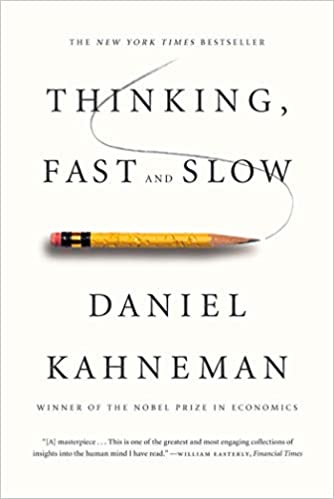Decision-making is a major part of the business. The higher you progress up the food chain, the more influence your decisions will have on your company’s direction, your business success or failure, and the people who make up your workforce.
Although this is fundamental to the business executive role, you need to be careful that your decision-making strategy is effective and that the decisions you reach are the right ones for your company.
People have written volumes about making business decisions, and the reason for this is that many of us struggle to do it effectively. Sometimes it may come down to thinking outside the box or just finding a different way to think about a problem. So let’s take a look at 7 effective business decision-making tips you don’t hear often.

Thinking Fast and Slow
by Daniel Kahneman
⏱ 12 minutes reading time
🎧 Audio version available
Use an Affinity Diagram.
An affinity diagram, also known as the KJ method (Japanese anthropologist Kawakito Jiro devised it), enables you to collect lots of information and sort it into natural groups that share characteristics or categories.
An Affinity Diagram works best with a group, such as in a brainstorming session. First, you describe the issue and ask each participant to write down each idea they have about it on separate post-it notes and then post each one on a whiteboard or flip chart. Then you discuss and sort out each note into groups that share characteristics or relate to the same category.
If ideas fit into more than one category, create a duplicate note and if an idea does not fit anywhere else, leave it as a standalone idea.
Once you have done this, the issue you may be struggling with may seem much clearer. In addition, once you are armed with this information from your team, you may be able to identify the problem and make the right decision to solve it.
Make a decision tree
A decision tree helps you break your decision down into possible outcomes from all the related choices you may be considering. You start with a single node and then add each choice and its most likely outcome, continuing with each branch until you reach a likely endpoint.
To do this, you use three types of nodes; a circle node representing a chance; a decision node, represented by a square that indicates the place where a decision should be made; and an end node representing the final outcome or each decision path.
You can make a decision tree yourself by writing the information out on a chart or whiteboard. There is also software available to do it for you.
This decision-making method is extremely popular and effective, but the downside is that it can quickly become unnecessarily complicated.
The Heuristic Model also known as Trial and Error
In business, as in life, sometimes you cannot predict everything that is likely to happen, so the best approach is to do it anyway and sort out any issues as they occur without making too many decisions beforehand.
This is known as the Heuristic approach and is a great way of trialing systems. These may not be 100% perfect right now, but after some trial and error, you will see the areas that need improvement. This system is great for launching a website, for example. It gets your system up and running, and you can return to it later to iron out any issues that may not be working effectively.
With the heuristic model, you react to issues rather than make decisions to prevent them before you start.
Take some time out for exercise
If you are struggling with a decision, taking time out for exercise will probably help you focus. Not only does exercise energize your mind and your body, but it also allows you some thinking time away from the business environment so it can offer a new perspective on your problem.
Sometimes the best ideas come into our minds when we are doing something unrelated, so solitary activities such as running, walking, swimming, or working out in the gym can lead to moments of clarity in decision making too. And if they don’t, at least you will be fitter and healthier than had you sat stressing in the office alone with your decision.
Cost/ Benefit Analysis
If you are making financial decisions for your business, running a cost/benefit analysis will help you decide whether your course of action is profitable for your company.
To do this, outline the possible cost of your decision and weigh this against the expected benefits you can expect. Doing this will help you gain a clearer perspective because if the costs of your decision far outweigh the benefits, it is probably not the right decision.
Game Theory
In business, your decision-making will often depend upon your negotiation skills with third parties such as your competitors, buyers, or suppliers. The problem with making these types of decisions is that you have no prior warning on what these third parties may do or say in the course of a negotiation.
Game theory is a way of preparing for the unexpected. The idea is that you use role-play to put yourself into the shoes of the third party so that you can anticipate their actions and reactions in advance.
Game theory involves set rules, and the games are either co-operative or non-cooperative. Players formulate strategies, and there are various rules and aspects to the game, including Players, Actions, Payoffs, and information known as PAPI. This system was devised in 1944 by mathematician John Von Neumann and economist Oskar Morgenstern and is considered an important method of decision-making and analysis.
Playing a role-playing game in a safe environment can help you make decisions based on the game’s outcome. That way, you should be ready for whatever decision you have to make in any bargaining situation.
Write a Pros and Cons list
Finally, reducing an executive business decision to a pros and cons list may seem over-simplistic, but the most simplistic solutions are often the best. With a pros and cons list, you can look at the advantages and disadvantages of a decision side by side and see which one looks best on paper.
If the results are too close to call, it shows you where you need to make a decision on any component of the list and where you need to make a new pros and cons list to deal with this particular issue.
A pros and cons list may seem like decision-making 101, but it can be surprisingly effective for even major business decisions.
What Is Snapreads?

With the Snapreads app, you get the key insights from the best nonfiction books in minutes, not hours or days. Our experts transform these books into quick, memorable, easy-to-understand insights you can read when you have the time or listen to them on the go.


